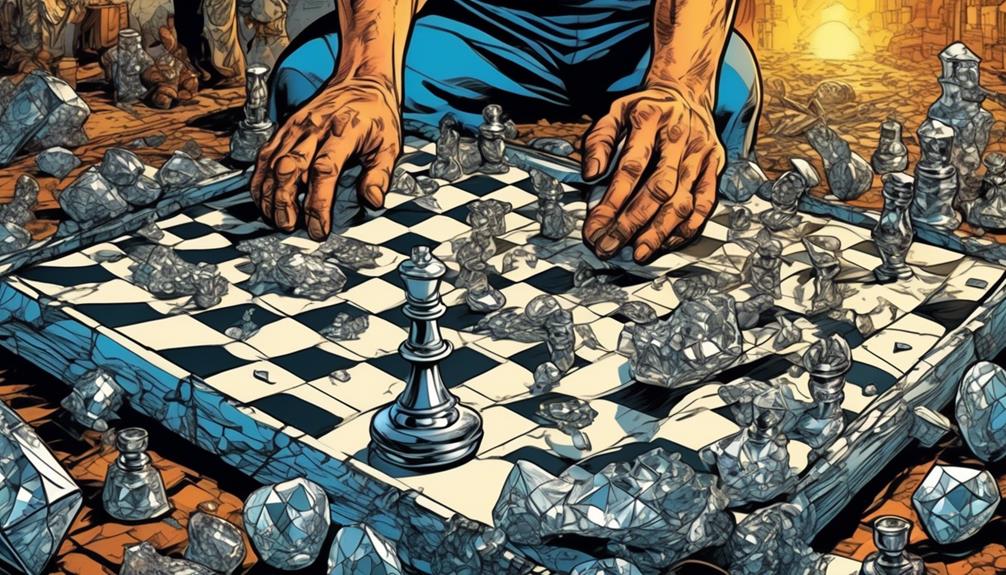You’ve seen the highs and lows of the diamond market, and now you’re witnessing a pivotal moment as Anglo American seems to be planning to take a decisive step with De Beers in 2024. The company leadership has announced that they may write down the value of De Beers.
By writing down the value of this iconic diamond company, they’re not just adjusting numbers on a balance sheet; they’re acknowledging the turbulent waters they’ve navigated in recent years. From plummeting diamond prices to declining demand, the challenges are stark, yet there’s a silver lining that Anglo American seems to grasp.
This move could signal a strategic pivot that aligns De Beers with the realities of today’s market while also setting the stage for future resilience. But what does this mean for the broader diamond industry, and how will it affect the global market dynamics?
Stick around, and let’s uncover the layers behind this significant financial manoeuvre and its potential ripple effects across the diamond world.
Article Contents
- 1 Key Takeaways
- 2 Background of A De Beers Write-Down
- 3 Factors Impacting the Diamond Market
- 4 Financial Implications for Anglo American
- 5 Future Outlook for Diamonds
- 6 Strategic Adjustments by Anglo American
- 7 Our Thoughts About A Potential Write Down Of De Beers Valuation
- 8 Frequently Asked Questions
- 9 Will Anglo American Write Down the Value of De Beers: Further Reading
Key Takeaways
- Due to market downturns and difficulties like the rise of lab-grown diamonds, De Beers, which Anglo American owns 84% of, is facing a significant value write-down.
- Declining demand for natural diamonds and the popularity of lab-grown diamonds are major factors contributing to the write-down.
- The diamond industry is undergoing a period of adjustment and potential innovation.
- The financial implications for Anglo American are significant, as the write-down could impact their financial statements and strain their bottom line.
Background of A De Beers Write-Down
Due to a combination of market downturns and new challenges, such as the rise of lab-grown diamonds, De Beers, a significant player in the diamond industry and a wholly owned subsidiary of Anglo American, is facing a sizable value write-down. This situation stems from various causes that have shaken the foundations of the diamond market.
You’re seeing a world where traditional symbols of luxury and exclusivity are being reevaluated, and De Beers is right at the heart of this transformation.
The challenges are multifaceted. It’s a tough scene, from declining demand for natural diamonds to the competitive landscape evolving with lab-grown diamonds becoming more popular. These industry trends aren’t just passing clouds; they signal a profound shift in what value and authenticity mean to people today. Once a niche market, lab-grown diamonds are now a significant force, offering a more affordable and ethical alternative to mined diamonds.
It’s clear that the diamond industry, as you know it, is changing. De Beers’ potential write-down is a reflection of these turbulent times. But it’s also a call to adapt and find belonging in this new, shifting competitive landscape. One potential way for De Beers to adapt to this changing landscape is through strategic partnerships, such as the recent Tanishq and De Beers partnership. By teaming up with other industry leaders, De Beers can leverage each other’s strengths and navigate the challenges of the global diamond trade. This could potentially help them stay relevant and competitive in this evolving market.
Factors Impacting the Diamond Market
Understanding these tumultuous times for De Beers sets the stage to explore what’s shaking the diamond market today. You’re probably wondering why the sparkle seems to have dimmed a bit in the world of diamonds. Well, it’s not just you noticing it; there’s a real shift happening. The biggest factor? Declining demand. People just aren’t buying diamonds like they used to, and it’s shaking up the industry.
Then there’s the rise of lab-grown diamonds. These sparklers are gaining popularity, offering a more budget-friendly and ethical alternative to traditional stones. It’s a game-changer, pushing the market to adapt or face the consequences.
But it’s not all about consumer choices. The diamond market is also wrestling with macro-economic challenges. From the slow retail recovery, especially in places like China, to the broader economic uncertainties affecting global spending habits, it’s a tough time for luxury goods.
And let’s not forget the voluntary moratorium. Diamond producers decided to cut back on supply to stabilize prices, but it’s a delicate balancing act. Too little, and it won’t make a dent. Too much, and they risk flooding the market when demand picks up.
If you’re feeling the shifts in the diamond market, you’re not alone. It’s a period of adjustment, but it’s also a time ripe for innovation and change.
Financial Implications for Anglo American
Anglo American’s possible decision to write down De Beers‘ value in 2024 could significantly impact its financial statements and overall profitability, highlighting the challenging times ahead for the company in the diamond market. This move underscores Anglo American’s financial challenges, with the unprofitability impact of De Beers potentially straining the company’s bottom line. It’s a clear signal of the consequences of the market turmoil that has shaken the diamond sector, exposing Anglo American to heightened risks. The potential write-down of De Beers’ value also raises concerns about the company’s long-term sustainability in the diamond industry. De Beers has been a cornerstone of Anglo American’s portfolio for many years, but now the company must confront the reality of its declining value. The decision to write down De Beers’ value reflects the increasingly uncertain and challenging dynamics at play in the diamond market.
You’re probably aware of how unpredictable the diamond market can be. The recent collapse in diamond prices and the subsequent overstocking have only added to these financial challenges, affecting Anglo American’s performance. Moreover, the company’s strategic acquisition amidst this turmoil, notably the purchase of the Oppenheimer family’s stake in De Beers, brings its own set of acquisition implications. It’s a bold move that could either bolster the company’s position or add to its financial strain, depending on how the market evolves.
The valuation of De Beers’ assets is more than just a number on a balance sheet; it’s a pivotal factor that will determine the future sustainability of Anglo American’s diamond business amidst these diamond sector risks.
Future Outlook for Diamonds
Looking ahead, the diamond industry’s future appears to be at a crossroads, facing significant challenges yet holding onto the potential for recovery. You’re likely aware that the sparkle of natural diamonds isn’t shining as bright these days, with demand on the decline. But the tale has a twist – lab-grown diamonds are gaining ground, capturing more of the market share. This shift is changing the game, especially as these eco-friendlier alternatives find their way onto mainstream platforms, winning hearts.
At the same time, the diamond world is feeling the pinch from currency fluctuations. Imagine that even the luxury watch industry, known for its resilience, is grappling with rising production costs. This scenario isn’t isolated; it mirrors broader economic pressures that could redefine luxury spending.
Yet, amidst these waves of change, there’s a glimmer of hope. The growing acceptance of lab-grown diamonds suggests a path forward where innovation and sustainability could lead to a vibrant recovery. So, as you stand at this junction, watching the evolving landscape, remember that the diamond industry might be transforming, but its inherent value and allure remain unshaken.
Strategic Adjustments by Anglo American

In response to the diamond industry’s downturn, Anglo American is making strategic adjustments to De Beers’ operations, aiming to keep the company competitive. These adaptation strategies are essential in navigating through the rough waters of industry challenges, including declining demand and the rise of lab-grown diamonds. By taking proactive steps, Anglo American is positioning De Beers to respond effectively to market changes, ensuring it remains at the forefront of the diamond industry.
You’re part of a community that values resilience and innovation. As such, it’s crucial to understand that these strategic measures aren’t just about overcoming current challenges but also about securing a place in the future of diamonds. By embracing adaptation strategies, De Beers isn’t just surviving; it’s aiming to thrive.
This commitment to competitive positioning reflects a broader intention to adapt to and shape the diamond market’s response to evolving consumer preferences and technological advancements.
Our Thoughts About A Potential Write Down Of De Beers Valuation
The diamond industry is at a pivotal moment as Anglo American takes decisive action with De Beers in 2024. The decision to write down the value of this iconic diamond company signifies a strategic pivot in response to the challenges facing the industry, including declining demand for natural diamonds and the rise of lab-grown alternatives. This move reflects the turbulent waters De Beers has navigated and sets the stage for future resilience and innovation.
As the broader diamond industry grapples with market dynamics and consumer preferences, the financial implications for Anglo American are significant. The write-down could impact their financial statements and bottom line, highlighting the company’s risks and uncertainties in the diamond market. However, it also presents an opportunity for strategic adjustments and competitive positioning to navigate the evolving landscape.
Looking ahead, the diamond industry faces challenges but holds potential for recovery and adaptation. The acceptance of lab-grown diamonds and the focus on sustainability and innovation offer a path forward for the industry. By embracing strategic adjustments, Anglo American and De Beers aim not only to survive in these changing times but to thrive and shape the future of diamonds.
As we witness this transformation in the diamond market, it’s clear that while the industry may evolve, diamonds’ enduring value and allure remain, promising a future where innovation and sustainability drive growth and resilience.
Frequently Asked Questions
How Much of De Beers Does Anglo American Own?
You’re curious about how much of De Beers Anglo American owns, right? Well, they own 84% of it. Botswana is the owner of the remaining balance.
This ownership isn’t just about having a slice of the pie; it’s a full commitment, reflecting its strategic importance in the diamond market.
For shareholders, this total control suggests a direct benefit from future gains.
And looking ahead, despite current challenges, projections hint at a sparkling future, making this a key asset in Anglo American’s portfolio.
What Are the Values of De Beers?
You’re looking at De Beers’ values?
Market dynamics, such as consumer demand and diamond valuation, shape them. Ethical concerns and supply chain integrity also weigh heavily. Despite recent industry challenges, their approach aims to balance profit with responsibility, navigating fluctuating demand and ethical sourcing.
It’s about offering you diamonds that sparkle and stand the test of responsible practices, ensuring you’re part of a community that values sustainability and ethics. At Joy Toledano Designs, we are committed to providing you with exquisite diamonds that not only bring beauty to your life but also contribute to the well-being of the environment and the people involved in the production process. Our dedication to sustainability and ethical practices means that you can enjoy your diamonds with peace of mind, knowing that they have been sourced and created with care and responsibility. Joy Toledano Designs offers a range of stunning diamond jewelry pieces that are crafted with the highest standards of quality and integrity. With our commitment to excellence and conscious practices, you can adorn yourself with diamonds that not only shine brightly but also uphold the values of sustainability and ethics.
What Is the Net Worth of Anglo American?
Anglo American has a market cap or net worth of 23.27 billion as of February 8, 2024
Despite challenges, their dedication to growing responsibly and embracing tech keeps them competitive. Their commitment to sustainability and rewarding shareholders shows they’re in it for the long haul.
Which Family Owns De Beers?
You’re probably wondering who owns De Beers, the diamond monopoly with a rich history.
It’s all about family legacy and global influence. Initially, the Oppenheimer family had a major stake, showcasing the deep roots of historic ownership. The family sold their shares to Anglo American in 2011. Up to that point, the family held 40% of De Beers.
However, there’s been a significant ownership transition, with Anglo American now at the helm. This shift highlights how the diamond world evolves, yet the legacy of those who’ve shaped it remains influential.
Will Anglo American Write Down the Value of De Beers: Further Reading
1: https://deal.town/jck-magazine/anglo-american-mulls-writing-down-value-of-de-beers-FKEUWVFDE
2: https://wallstreet-now.com/en/articles/2024/02/08/anglo-american-plc-faces-potential-write-down-of-de-beers-unit-amid-diamond-industry-downturn
3: https://www.voxmarkets.co.uk/articles/anglo-s-de-beers-sees-diamond-sales-jump-in-first-sale-of-2024-80589c0/






